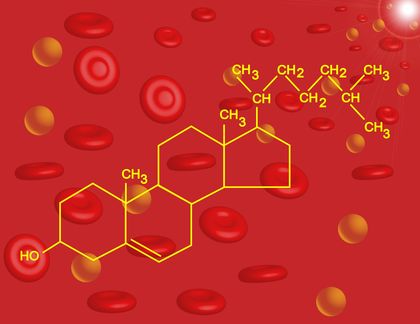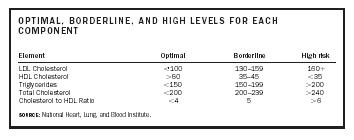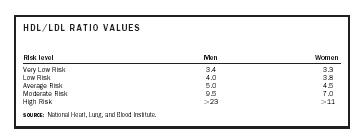Lipid Profile

Cardiovascular disease (CVD) is a major cause of death in the world and is mainly due to atherosclerosis (hardening of the arteries ). Abnormal blood lipids are risk factors for CVD.

| Element | Optimal | Borderline | High risk |
| SOURCE : National Heart, Lung, and Blood Institute. | |||
| LDL Cholesterol | <100 | 130–159 | 160+ |
| HDL Cholesterol | >60 | 35–45 | <35 |
| Triglycerides | <150 | 150–199 | >200 |
| Total Cholesterol | <200 | 200–239 | >240 |
| Cholesterol to HDL Ratio | <4 | 5 | >6 |
Blood Lipids and Lipid Transport
Lipids are insoluble (does not dissolve) in water but are soluble (dissolves) in alcohol and other solvents. When dietary fats are digested and absorbed into the small intestine, they eventually re-form into triglycerides , which are then packaged into lipoproteins .
Dietary fats, including cholesterol , are absorbed from the small intestines and transported into the liver by lipoproteins called chylomicrons. Chylomicrons are large droplets of lipids with a thin shell of phospholipids , cholesterol, and protein . Once chylomicrons enter the bloodstream, an enzyme called lipoprotein lipase breaks down the triglycerides into fatty acid and glycerol . After a 12- to 14-hour fast, chylomicrons are absent from the bloodstream. Thus, individuals who are having a lipid profile done should fast overnight to ensure that chylomicrons have been cleared.
The liver removes the chylomicron fragments, and the cholesterol is repackaged for transport in the blood in very low-density lipoproteins (VLDLs), which eventually turn into low-density lipoproteins (LDL). LDL cholesterol (LDL-C)—the "bad cholesterol"—consists mainly of cholesterol. Most LDL particles are absorbed from the bloodstream by receptor cells in the liver. Cholesterol is then transported throughout the cells. Diets high in saturated fats and cholesterol decrease the uptake of LDL particles by the liver. LDL particles are also removed from the bloodstream by scavenger cells, or macrophages, which are white blood cells that bury themselves in blood vessels such as arteries. Scavenger cells prevent cholesterol from reentering the bloodstream, but they deposit the cholesterol in the inner walls of blood vessels, eventually leading to the development of plaque.
High-density lipoproteins (HDLs) are a separate group of lipoproteins that contain more protein and less cholesterol than LDL. HDL cholesterol (HDL-C) is also called "good cholesterol." HDL is produced primarily in the liver and intestine, and it travels in the bloodstream, picks up cholesterol, and gives the cholesterol to other lipoproteins for transport back to the liver.
Lipid Profile
A lipid profile measures total cholesterol, HDL cholesterol, LDL cholesterol, and triglycerides. A physician may order a lipid profile as part of an annual exam or if there is specific concern about CVD, especially coronary artery disease. The National Cholesterol Education Program recommends that individuals age twenty and over have a fasting lipoprotein profile every

| Risk level | Men | Women |
| Very Low Risk | 3.4 | 3.3 |
| Low Risk | 4.0 | 3.8 |
| Average Risk | 5.0 | 4.5 |
| Moderate Risk | 9.5 | 7.0 |
| High Risk | >23 | >11 |
| SOURCE : National Heart, Lung, and Blood Institute. | ||
five years. A lipid profile should be done after a nine- to twelve-hour fast without food, liquids, or medication. If fasting is not possible, the values for total cholesterol and HDL-C may still be useful. If total cholesterol is 200 milligrams per deciliter (mg/dl) or higher, or HDL-C is less than 40 mg/dl, the individual will need to have a follow-up lipoprotein profile done to determine LDL-C and triglyceride levels.
Depending on the physician's request, the lipid profile may include the ratio of cholesterol to HDL. This ratio is sometimes used in place of total blood cholesterol. The ratio is obtained by dividing the HDL cholesterol level by the total cholesterol. For example, if a person has total cholesterol of 200 mg/dl and an HDL cholesterol level of 50 mg/dl, the ratio is 4:1. The goal is to keep the ratio below 5:1, and optimally at 3.5:1. There are several over-the-counter cholesterol measuring devices on the market, but none has been endorsed by any medical organizations.
Treating Abnormal Blood Lipids
The National Cholesterol Education Program, the American College of Cardiology, and the American Heart Association recommend diet and lifestyle modification as the first line of defense against abnormal blood lipids. These recommendations include a diet low in total fat , saturated fat , and cholesterol; a diet high in fiber ; weight loss or weight management; increased physical activity; smoking cessation; increased intake of plant sterols (e.g., margarines and salad dressings made with soybean sterols); and daily use of a low-dose aspirin. Drug therapy may be required for high-risk individuals. Cholesterol-lowering drugs works to lower LDL by reducing cholesterol synthesis and by binding bile acids in the small intestines. However, there are possible side effects to these drugs that patients should be aware of.
SEE ALSO Arteriosclerosis ; Atherosclerosis ; Cardiovascular Diseases ; Fats .
Delores C. S. James
Bibliography
Birtcher, Kim K., et al. (February 2000). "Strategies for Implementing Lipid-Lowering Therapy: Pharmacy-Based Approach." American Journal of Cardiology 85(3):30–35.
National Cholesterol Education Program (2001). Third Report of the National Cholesterol Education Program Expert Panel on Detection, Evaluation, and Treatment of High Blood Cholesterol in Adults (Adult Treatment Panel III), Executive Summary. NIH Publication No. 01-3670. Washington, DC: National Institutes of Health.
Wardlaw, G.; Hampl, J.; and DiSilvestro, R. (2004). Perspectives in Nutrition, 6th edition. Boston, MA: McGraw-Hill.
Internet Resources
American Heart Association. "Cholesterol, Home Testing Devices." Available from <http:/www.americanheart.org>
Lab Tests OnLine. "Lipid Profile." Available from <http://www.labtestsonline.org>
National Heart Lung and Blood Institute. "Recommendations for Lipoprotein Measurement." Available from <http://www.nhlbi.nih.gov/prof/heart>

Comment about this article, ask questions, or add new information about this topic: